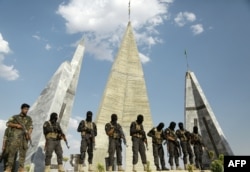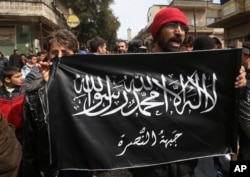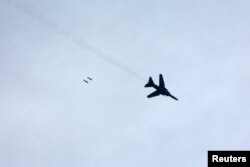A significant quantity of weapons supplied by Western and Gulf states to opposition factions battling the regime of President Bashar al-Assad in the Syrian conflict were transferred to the Islamic State, according to a study funded by the European Union and Germany’s foreign ministry.
The leakage of the supplies “significantly augmented the quantity and quality of weapons available to IS forces -- in numbers far beyond those that would have been available to the group through battlefield capture alone,” according to Weapons of the Islamic State, a 202-page study released Wednesday.
Conflict Armament Research (CAR), a Britain-based organization that monitors the movement and diversion of weapons in conflict zones, produced the study.
“The acquisition of weapons by the Islamic State group is classic blowback - 1980s Afghanistan replayed in Syria,” says CAR’s executive director James Bevan. He adds, “Time and again, states that seek to accomplish short-term political objectives supply weapons to groups over whom they exert little-to-no control. These weapons often gravitate to the most organized and effective rebel and insurgent forces.”
CAR researchers say they had the full cooperation of national governments and manufacturers for their three-year investigation, which involved sending teams to cover an unbroken arc of territory extending from the northern Syrian city of Kobane to the south of the Iraqi capital, Baghdad. Western governments furnished lists of brokers and shippers, as well as serial numbers of the exported weapons and ammunition.
That, CAR researchers say, shows the governments' determination “to curb the supply of weapons and associated materiel to unauthorized users.” The report notes the governments and manufacturers were not acting unlawfully when dispatching arms and ammunition to the Syrian insurgents, there was no international arms embargo in effect.
Armories looted
CAR field researchers analyzed more than 40,000 items recovered from IS forces between 2014 and 2017. Many of the items originated in shipments that ran into the thousands. IS seized large quantities of weapons in Syria from retreating Assad forces and were able to loot government arsenals.
And in Iraq, there was a large-scale capture of weapons by IS in 2014 as the government’s security forces fell back rapidly in the face of the terror group’s blitz in Northwest Iraq and Mosul.
But the fact IS often acquired weapons supplied by outside powers within weeks and months of their delivery to opposition factions is less well recognized, says CAR in its study.
It remains unclear how IS secured the weaponry supplied by foreign powers to Syrian rebel groups: some could have been captured or sold by recipient militias, says a European official. Rebel fighters say some weaponry was shared or bartered with jihadist factions which subsequently joined IS.
Western media outlets, including VOA, did report from the frontlines from 2013 onwards that Western and Gulf-supplied weapons were being traded, transferred and sold by opposition fighters and commanders to jihadist groups such as al Qaida affiliate Jabhat al-Nusra and IS.
In 2013, a senior German diplomat told VOA his government and several other European Union governments were resisting an Anglo-French push for the West to increase the flow of weapons to Syrian rebels for fear the equipment could fall into the hands of jihadist groups.
Those fears were shared by U.S. officials. President Barack Obama refused constant appeals from the rebels and Gulf states of Saudi Arabia and Qatar to increase arms supplies dramatically. Obama also declined to give the insurgents anti-aircraft missiles, fearing the consequences if any fell into jihadist hands, officials told VOA in 2014 and 2015.
Obama officials put in place various mechanisms to try to track weapons supplied to opposition factions and with TOW missiles they would only provide re-supplies when evidence had been offered by rebel units to show how they had used the missiles. But without military observers, there was an element of trust involved. Video evidence could be doctored, officials admitted to VOA during the conflict.
According to CAR, the arms that fell into the hands had serious impact on the battlefield, and continue to pose a significant threat, especially anti-armor weapons such as the BGM-71 TOW anti-tank missiles.
The report states, "The weapon was manufactured in the EU, sold to the United States, supplied to a party in the Syrian conflict, transferred to IS forces in Iraq, and documented by a CAR field investigation team following its recovery from IS forces. The full chain of transactions occurred within two months of the weapon’s dispatch from the factory.”
Many countries involved
Russia and China manufactured more than 50 percent of the weapons and ammunition held by IS forces, CAR calculates. Those arms were captured from Syrian or Iraqi forces.
“Former Warsaw Pact countries that are now EU Member States manufactured a significant proportion of the remaining materiel (more than 30 percent of weapons and 20 percent of ammunition).”
CAR researchers note: “Nearly 40 percent of ... anti-armor rockets deployed by IS forces in Iraq were produced in the past four years. ... EU Member States produced nearly 20 percent of these post-2014-manufactured rockets ... a fact that sits uncomfortably with the EU’s parallel efforts to degrade the group’s capacity to wage war and terrorism and to mitigate the international effects of the Syrian conflict.”
CAR also documented ammunition that came from Eastern European states, exported to the United States and then dispatched to Somalia. Researchers also found matching lot numbers among IS rockets documented by CAR in Iraq, Syria, and Yemen.
Identical weapons deployed by IS forces in Syria, had previously been spotted in circulation with armed groups in South Sudan, supplied illicitly by the Sudanese government.
Also, “A Libya–Syria weapon pipeline has operated since at least 2012” say CAR researchers, but they add that “the precise transfer mechanics are unclear.”












